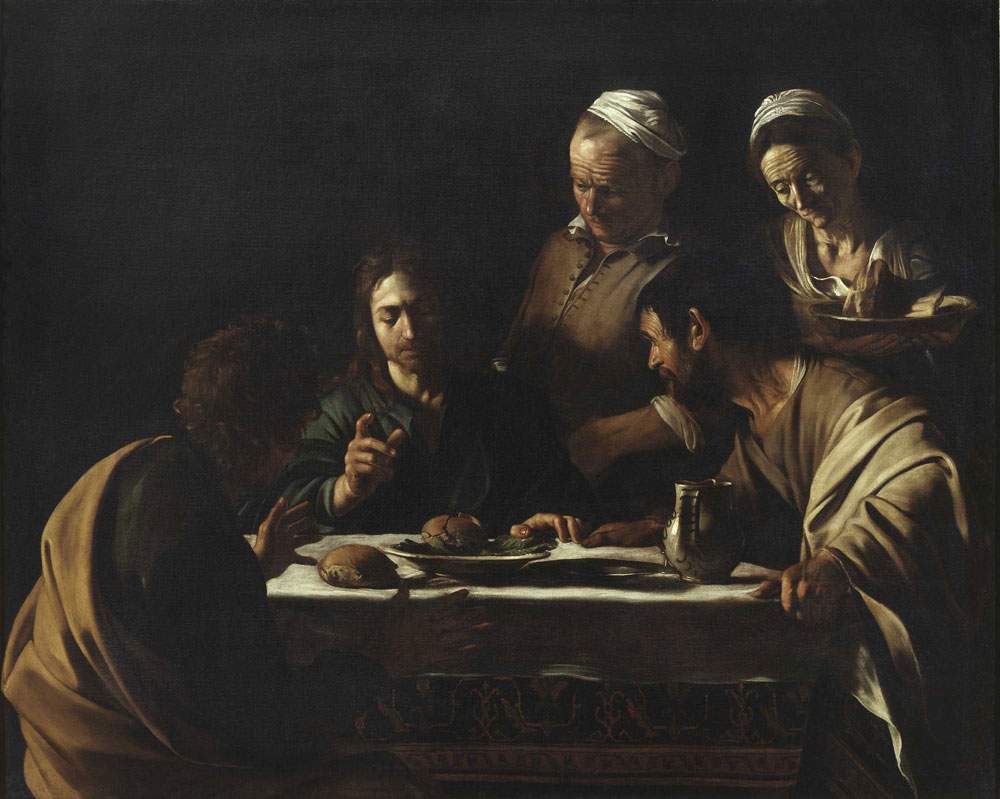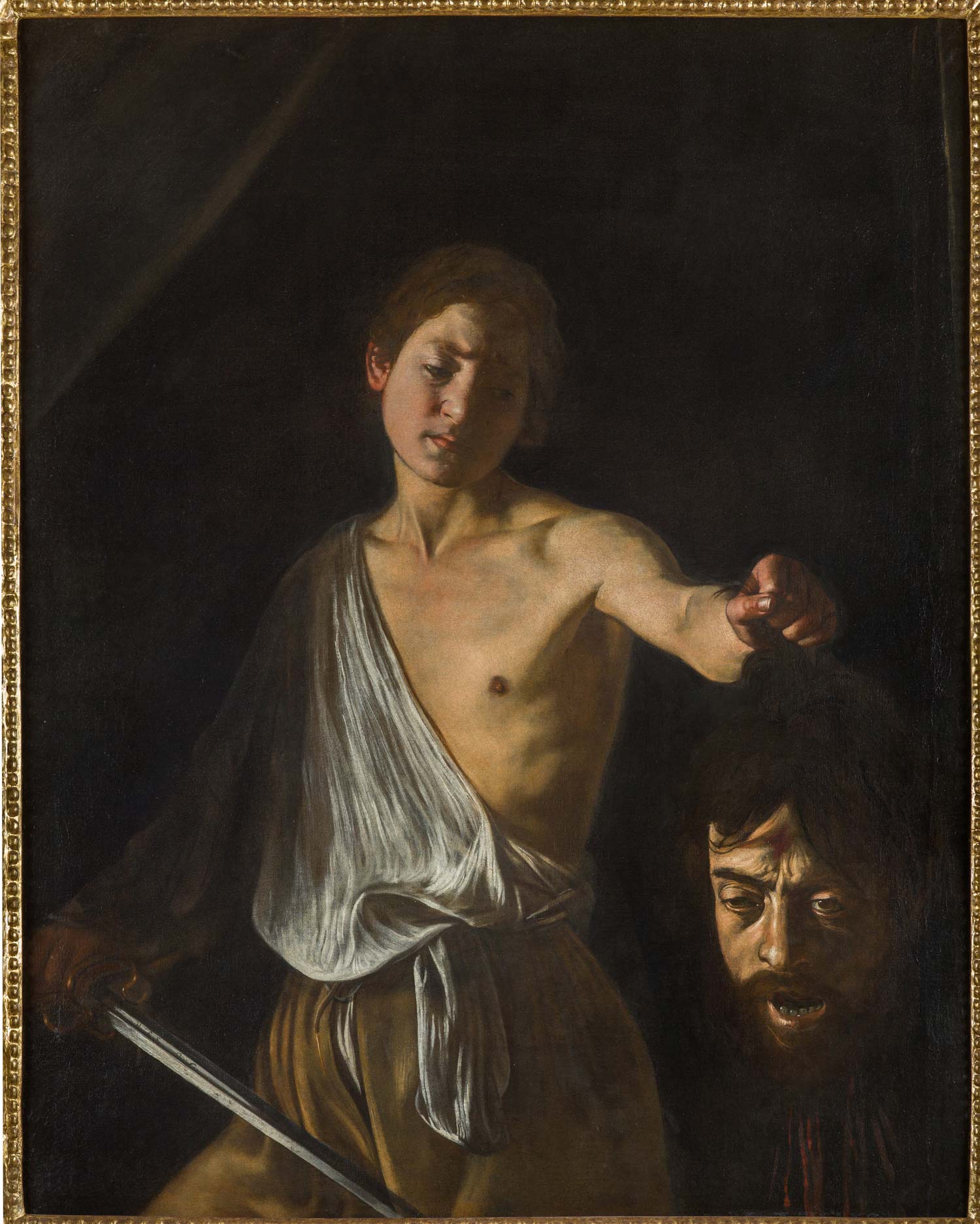In Milan, the Pinacoteca di Brera resumes its “Dialogues,” the traditional comparisons between major works in its collection and guest paintings, initiated by director James Bradburne in 2016. The appointment comes to non-dialogue with an exhibition that has at its center one of the greatest protagonists of art history of all time: Caravaggio. In fact, from June 21 to September 25, 2022, the museum presents Caravaggio, Ninth Dial ogue, which will juxtapose two masterpieces by the Lombard genius such as The Supper at Emmaus from the Pinacoteca di Brera and David with the Head of Goliath from the Galleria Borghese in Rome.
The Ninth Dialogue is the third appointment to host works by Caravaggio in the Pinacoteca: an exhibition in 2009, Caravaggio hosts Caravaggio, curated by Mina Gregori and Amalia Pacia, had first compared the Supper in Emmaus from Brera with the Supper in Emmaus from the National Gallery in London, dated 1602, and in the catalog there were important contributions on the two works and their critical vicissitudes. A more recent event, in 2017, Around Caravaggio. A Question of Attribution, curated by Nicola Spinosa and James Bradburne, had made it possible to look at some of Louis Finson’s seventeenth-century copies on display and to reason about a complex attributive affair, that of the Judith of Toulouse. The new exhibition on Caravaggio, curated by Letizia Lodi, will give the public a chance to be able to witness an event that stages a never-before-seen comparison: in fact, the two paintings, both belonging to the artist’s late production, executed between Rome and Naples, will be exhibited side by side for the first time, with the public and scholars called to reason and confront the issue of the dating of David with the Head of Goliath, still much debated by critics, thanks in part to recent studies by Maria Cristina Terzaghi, Francesca Cappelletti, Rossella Vodret, Alessandro Zuccari, Antonio Iommelli, and Gianni Papi.
“Debates about paintings not only revolve around attribution-that is, the identity of the artist-and even when this does not seem to be in dispute, as in the case of the Caravaggio in the Galleria Borghese-but another fundamental element of a painting’s history is when it was made,” says James Bradburne, director of the Pinacoteca di Brera and the Braidense Library. “Knowing exactly when a work was finished is essential to understand its context, iconography, and above all to place it exactly in the evolutionary path of the artist.”
The current dialogue thus features a somewhat enigmatic masterpiece by Caravaggio, the Borghese Gallery’s David with the Head of Goliath, granted to the Pinacoteca in exchange for the loan of Guido Reni’s painting, St. Paul Reprimands Peter the Penitent, for the Guido Reni exhibition in Rome, curated by Francesca Cappelletti, which closed a few weeks ago with Reni’s painting returned to the same room 28 where the Supper at Emmaus is on display and the Caravaggio exhibition is staged. The opportunity to admire the two works through a close comparison will allow the public to grasp the details, even the gory ones of extreme realism, of the Borghese painting: such as the severed head of the Goliath, a probable self-portrait of the artist; Caravaggio’s peculiar color drafts; the gleam of the sword, with the Augustinian motto “H-AS-OS” (“Humilitas occidit superbiam”) initialed in the shell; the small folds of David’s white shirt. Always at the center of intense critical debate, not least because of the different nuances of its meaning, the David with the head of Goliath undeniably expresses the human drama experienced by the Lombard artist, who, fleeing Rome in 1606 on charges of the murder of Ranuccio Tomassoni, found hospitality first in the Colonna estates in Paliano and then in Naples, again thanks to the protection of the powerful Colonna family. The choice of subject, David’s victory over the giant Goliath, is most likely due to the artist himself. The Borghese’s version of the painting depicts a departure from the traditional depiction of the triumphant David, an example of victorious virtue: the young hero holds in his right hand the sword with which he has just struck the fatal blow to Goliath, while he turns a compassionate and melancholy gaze to the severed head of the defeated giant. “The self-portrait of Goliath’s face dripping with blood is particularly dramatic, with that lump of wrinkles on his forehead that preludes to the vacuity of his eyes, stopped in a lopsided gaze and the scream fixed by death” (Cappelletti, 2010). The complexity of the underlying narrative aspects and the work’s tragic charge are amplified by the presence of thepainter’s self-portrait in the head of the defeated giant, which is already mentioned in seventeenth-century sources, also in relation to the painting’s first owner, Cardinal Scipione Borghese.
With respect to the exact dating of the work, as James Bradburne explains in the essay that opens the exhibition catalog, there are several hypotheses about the date when Caravaggio painted David and Goliath. Some argue that it was executed in Rome, shortly before the assassination of Ranuccio Tomassoni and his subsequent escape to Naples through the estates of his protectors Colonna. Some scholars place the execution after his arrival in Naples; others believe the work to be contemporary with the Brera painting, thus included among the three executed on the Colonna estate during the summer of 1606. While most critics today believe that the canvas was executed during Caravaggio’s second stay in Naples, thus toward the end of 1609, as evidenced also by theuse of color, the treatment of light and other elements typical of works of that period, recent studies argue that the date of the painting’s completion should be placed between the end of the Roman period and the first months of the Neapolitan stay, a thesis that would not only not exclude the reference to forgiveness, suggested by the giant’s severed head-the death sentence pronounced in 1606 was known to the artist-but would also better explain the stylistic similarity with the Brera masterpiece, something that now with this dialogue visitors can directly assess.
The exhibition is accompanied by a catalog published by Marsilio, which, in addition to James Bradburne’s contribution, includes essays by Francesca Cappelletti, Antonio Iommelli, Letizia Lodi, and Maria Cristina Terzaghi, who delve into various topics, such as the presence of the David in Scipione Borghese’s collections and its passage to the Museum, Caravaggio’s production between Rome and Naples and, of course, its dating, the files of the two masterpieces, the Supper at Emmaus in the Brera Art Gallery, from itspurchase in 1939, to the 1940 exhibition , to the recent arrangements , some correspondence between the protagonists such as Ettore Modigliani, Guglielmo Pacchioni, Fernanda Wittgens, Giulio Carlo Argan, and a photo gallery of details of the two paintings.


The Supper at Emmaus in Milan is a second version, very different from the first (now in the National Gallery in London) that Caravaggio painted of the same subject, that is, the moment of the revelation of the identity of the risen Jesus to the two disciples returning from Emmaus who had mistaken Christ for a wayfarer. The painting dates to a particular and dramatic moment in the artist’s life: his escape from Rome, wounded, after the murder of Ranuccio Tomassoni on May 28, 1606. Merisi, hiding in the Colonna family’s fiefs in Palestrina, Paliano and then Zagarolo, awaiting sentencing, according to sources (Mancini 1620; Baglione 1642; Bellori 1672; Baldinucci 1681-1728) painted a Supper in Emmaus and a Magdalene in Ecstasy, presumably to put the works up for sale and scrape together enough for his subsequent escape that would take him to Naples. The Supper, recorded from 1624 in the collection of the Patrizi family, was sold again only in 1939, when the Associazione Amici di Brera, with the help of two Milanese patrons, bought it for the Pinacoteca. Compared to the London version, the painting has a more sparse color palette and a more immediate and rapid pictorial layering, which at times reveals the underlying preparation. The scene is immersed in a darkness that occupies a substantial portion of the canvas and ushers in the mature phase of Merisi’s work; the semicircular composition bordered by the gestures and cloaks of the disciples focuses attention on Christ’s face, half-lit by a light, coming from the left, that becomes the symbol and means of the unveiling: the moment described is that of the farewell to the disciples, with the blessing of the broken bread, in re-enactment of the Last Supper.
The David with the Head of Goliath was most likely executed in Naples, where Caravaggio, having fled Rome in 1606, was in exile on charges of murder. The choice of subject, with the victory of Israel’s hero over the Philistine giant Goliath, was probably due to the painter himself. David does not manifest a proud attitude of triumph as he holds and observes Goliath’s severed head; his expression is rather one of pity toward that “sinner,” in whose face Caravaggio would depict his own self-portrait. The description of Goliath’s face, so vividly expressive in the wrinkled forehead, the mouth wide open for his last breath, the suffering gaze, the lifeless complexion, represents the result of the human drama experienced by the artist. The inscription that appears on the sword “H.AS O S” has been dissolved by critics with the Augustinian motto Humilitas occidit superbiam. The biblical episode thus becomes striking evidence of the last months of Caravaggio’s life, making plausible the hypothesis that the painter sent the canvas to Cardinal Scipione Borghese as a gift to be delivered to Pope Paul V in order to obtain his pardon and return to his homeland. The pardon was granted but Caravaggio, almost at the end of the journey to Rome, died on the beach of Porto Ercole under circumstances that are still mysterious.
 |
| Brera Art Gallery showcases Caravaggio's Supper at Emmaus and David alongside |
Warning: the translation into English of the original Italian article was created using automatic tools. We undertake to review all articles, but we do not guarantee the total absence of inaccuracies in the translation due to the program. You can find the original by clicking on the ITA button. If you find any mistake,please contact us.